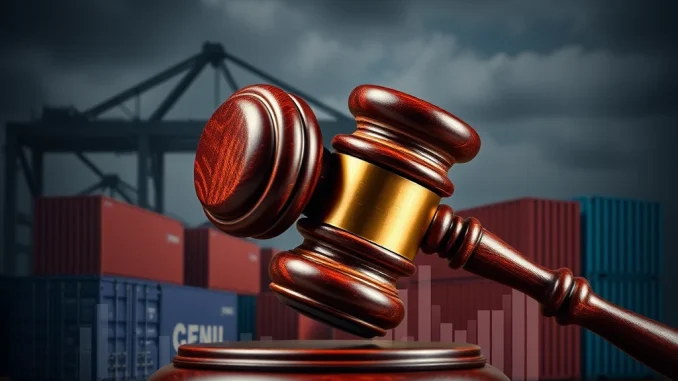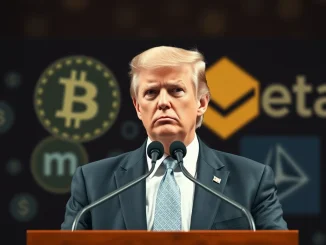
In the dynamic world of global finance, political and economic developments constantly shape market sentiment. For those tracking cryptocurrencies, understanding these broader forces, like shifts in US trade policy and potential legal battles, is crucial. A recent report highlights a significant declaration from former President Donald Trump regarding his stance on tariffs and a potential court challenge. This news, while not directly about digital assets, underscores the ongoing uncertainty in the global economic landscape that can influence investor behavior across all asset classes.
Donald Trump’s Stance on Trade Tariffs
According to a report shared by Walter Bloomberg on X, former U.S. President Donald Trump has explicitly stated his determination to prevail in an anticipated court battle concerning tariffs. This declaration signals a potential legal showdown over trade policy tools that have been a hallmark of Trump’s economic approach.
Tariffs, essentially taxes on imported goods, are often used by governments to protect domestic industries or as leverage in trade negotiations. Under the Trump administration, tariffs were notably imposed on goods from countries like China, leading to significant trade disputes. These actions aimed to address perceived unfair trade practices and reduce trade deficits.
What Does This Tariff Court Battle Involve?
While the specific details of the court case Trump referred to were not immediately available in the initial report, such legal challenges typically arise when the legality or implementation of tariffs is questioned. Potential grounds for challenging tariffs in court can include:
- Whether the executive branch acted within its statutory authority in imposing the tariffs.
- Whether proper administrative procedures were followed.
- Challenges based on international trade agreements (though domestic courts primarily rule on domestic law).
A court battle implies a formal legal challenge has been filed or is expected, potentially by affected businesses, industry groups, or even other government entities, seeking to overturn or modify the imposed tariffs.
Understanding the Economic Impact of US Trade Policy Disputes
Trade policy disputes, particularly those involving significant tariffs and legal challenges, can have wide-ranging economic consequences. These can include:
- Increased Costs: Tariffs raise the cost of imported goods, which can be passed on to consumers or absorbed by businesses, impacting profitability.
- Supply Chain Disruption: Businesses relying on imported components or materials may face disruptions and need to seek alternative suppliers, often at higher costs.
- Retaliation: Targeted countries often respond with their own retaliatory tariffs, escalating trade tensions and harming export-oriented industries.
- Investment Uncertainty: Legal battles and policy unpredictability create an uncertain environment, potentially deterring business investment.
- Inflationary Pressures: Higher import costs can contribute to inflation.
For market participants, including those in the crypto space, these factors contribute to the overall macroeconomic picture. Economic uncertainty stemming from trade wars and policy disputes can influence investor risk appetite, potentially leading to shifts in capital allocation across different asset classes.
Why Donald Trump’s Vow Matters
Donald Trump’s public declaration of intent to win the court battle underscores his commitment to his trade policy approach. His willingness to fight legally indicates that tariffs remain a key tool he supports, and he is prepared to defend their use against challenges. This is significant for several reasons:
- It reinforces the potential for continuity or return to a more protectionist trade stance depending on future political developments.
- It signals potential prolonged legal challenges, which can extend the period of uncertainty for businesses and markets.
- It highlights the potential for trade policy to remain a contentious issue, influencing international relations and global economic stability.
While crypto markets often react to their own unique drivers (like technological developments, adoption rates, and regulatory news specific to digital assets), they are not immune to the effects of major global economic shifts and political events. Developments in US trade policy and related legal battles contribute to the complex web of factors that shape the broader financial environment.
Looking Ahead: Potential Outcomes and Their Implications
The outcome of any tariff court battle involving Donald Trump could have notable implications:
| Outcome | Potential Implications |
|---|---|
| Trump Wins | Affirms the legality of the specific tariffs; reinforces the executive’s power in trade policy; potentially prolongs tariff application; signals continuity in trade approach. |
| Trump Loses | Could lead to the reversal or modification of specific tariffs; might constrain future executive actions on trade; could alleviate some economic pressures but also create new adjustments for businesses. |
Market participants will watch closely for developments in any such legal proceedings, as they could provide clearer signals about the future direction of US trade policy and its potential economic impact. While it’s challenging to draw a direct line from a tariff court case to the price of Bitcoin or Ethereum, the cumulative effect of global economic stability, trade relations, and policy predictability certainly plays a role in the overall health and sentiment of financial markets, including the burgeoning digital asset space.
Conclusion: Monitoring the Broader Economic Currents
Donald Trump’s vow to win a potential tariff court battle is a reminder that significant political and legal challenges are ongoing in the realm of global trade. While this news may seem distant from the world of blockchain and cryptocurrencies, it is part of the larger economic and political narrative that influences markets worldwide. For crypto investors, staying informed about such developments provides valuable context for understanding potential shifts in investor sentiment, market liquidity, and the overall macroeconomic environment. As this story unfolds, its resolution could offer further clarity on the direction of US trade policy and its subsequent economic ripple effects.



